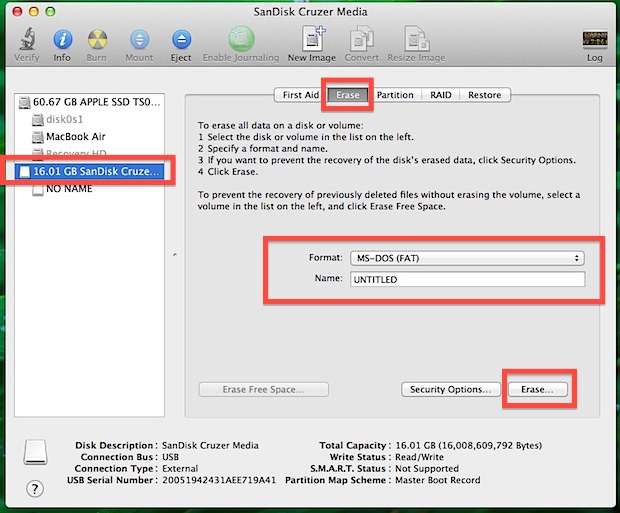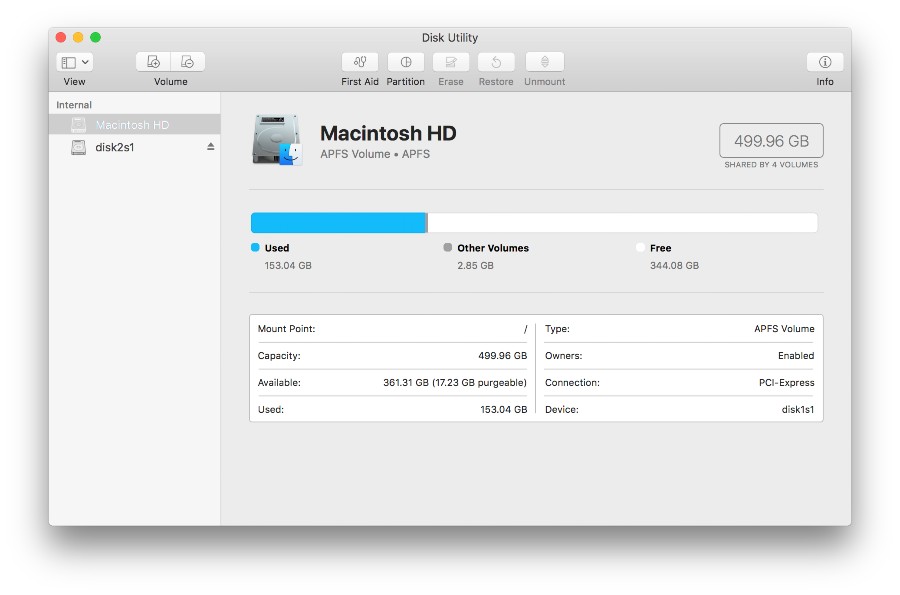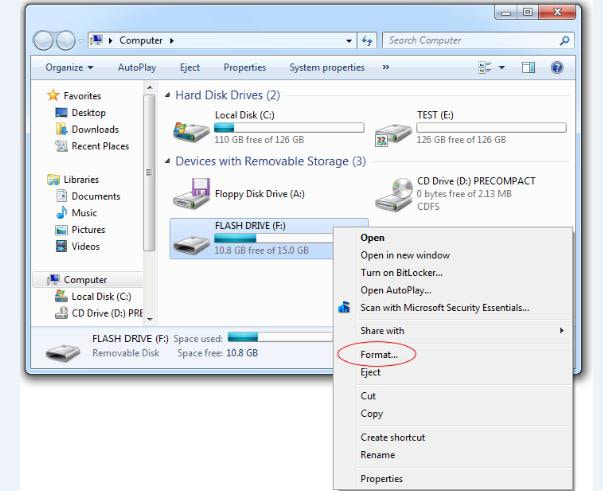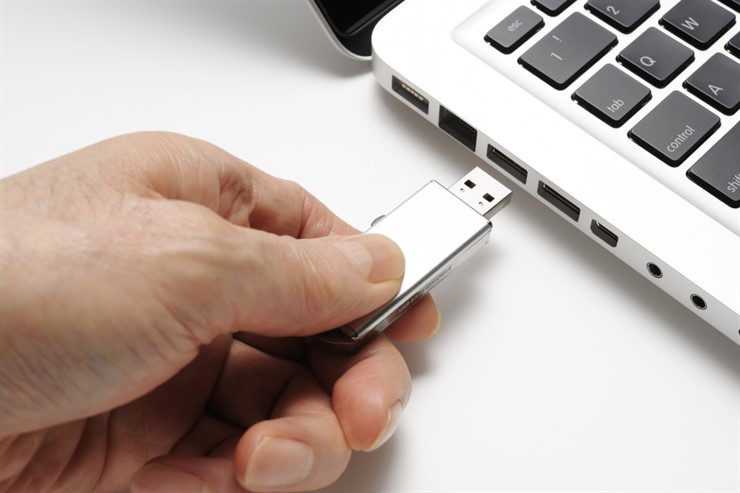/File Shredder /How to Format A Flash Drive on Mac
If you have an old flash drive or one that was formatted to work with Windows or another operating system, you can still format your flash drive to work on a Mac. Volume Format Most manufacturers use the FAT 32 or MS-DOS (FAT) volume format. How to format a USB drive on a Mac 1. Plug the drive into a USB socket (if you have a recent MacBook or MacBook Pro that only has USB-C connectors, you’ll need a USB-C to USB-A adaptor).
I just bought a flash drive, and it seems to be working really slowly on my Mac. What should I do?
You need to format your flash drive on Mac to make it compatible with your Mac. We’ll teach you how in this article. Read away!
Here are the tactics you’ll learn about in this post.
Article GuidePart 1. Why Format Your Flash Drive?Part 2. How to Format a Flash Drive on MacPart 3. Use PowerMyMac File Shredder to Delete Files on Your Flash DrivePart 4. Conclusion
Part 1. Why Format Your Flash Drive?
There are various reasons why you have to format your flash drive on Mac. Here are the three common ones:
Ensure the flash drive’s full compatibility with Mac. Most flash drives are pre-formatted for use with Windows.
The difference between macOS and Windows is that they make use of different file systems. Mac uses either Mac OS Extended or AFPS as the file system, while Windows usually uses FAT32.
Drives that are formatted as FAT32 can still be used with macOS, but there is a bigger chance that you’ll encounter issues along the way.
Aside from that, Time Machine doesn’t work with drives that are not fully compatible with Mac. Time Machine is a built-in feature of Mac that backs up your files to an external storage device such as your flash drive.
Free up space in your flash drive. USB drives have limited memory space. Sometimes, deleting unnecessary files or transferring a few of them to your PC is enough.
Sometimes, it isn’t. That is when formatting your USB drive becomes the best solution.
Get rid of viruses and other issues. Flash drives are popular for their portability, but they can also carry viruses that can spread to other computers.
Formatting a flash drive on Mac is an easy yet effective way to remove them. Although macOS is generally much safer and more secure than Windows, this doesn’t mean that your Mac can’t be affected by viruses.
Part 2. How to Format a Flash Drive on Mac
Before you proceed with formatting your flash drive, you should first consider which format you are going to use. Selecting the correct format is crucial as it will have an impact on its compatibility with your Mac.
Certain formats work better on specific versions of macOS. The format that you set is something you’ll have to stick with for a long time, so it’s best if you make the right decision from the very start.
Below are the available formats and when best to use them.
APFS. Short for Apple File System, APFS only works with Mac running on High Sierra or later.
It is optimized for solid state drives (SSD) like flash drives, and this guarantees a faster performance than Mac OS Extended.
If you intend to use your USB drive only with a new Mac, APFS is highly recommended. The downside to it is that it isn’t Time Machine-compatible.
This means you cannot set the flash drive as the destination of your backup.
Mac OS Extended. If your Mac is running on macOS Sierra or below, this format is the way to go. Nevertheless, Mac OS Extended works with High Sierra and up as well.
This would work well if you think you would need to use your drive in an old Mac. It has some catching up to do in terms of speed, though.

On the bright side, you can use your flash drive to create backups via Time Machine.
FAT32. The most versatile in the list, FAT32 will allow you to use your USB drive on Windows as well as a Mac. In fact, it is the most widely compatible file system.
It works on most video game consoles, media players, and other devices. However, it can only support individual files up to 4GB in size.
We don’t suggest using this format if you plan to store large files like videos.
exFAT. This is closely similar to FAT32 in terms of compatibility. It works on both Windows and macOS too.
However, it is not supported by as many consoles and devices as FAT32. The great thing here is that it doesn’t have a file size limit.
If you want full compatibility with Mac, choose between APFS and Mac OS Extended. If you expect to transfer files between a Windows computer and a Mac, you should decide on either FAT32 or exFAT.
If you are merely freeing up space or getting rid of viruses in your flash drive, simply select the previous format.
Now, have you decided which format would best suit you and your Mac? If you have, refer to our step-by-step guide on how to format a flash drive on Mac.
Step 1: Plug the flash drive into the USB port.
Newer models of MacBook and MacBook Pro only come with USB-C ports. You will need to connect a USB-C adaptor on the port before you can connect your flash drive.
Step 2: Launch a Finder window.
Open a Finder window. You should see your flash drive listed below the Devices section.
Click on it. If you have files in your drive, make sure to transfer them to your Mac or another external storage device. Formatting your flash drive will wipe off all files in it.
Step 3: Run Disk Utility.
Now, go to Applications and select Utilities. Click Disk Utility to open it and press on your flash drive’s name from the sidebar. Click on the Erase tab at the top of the window.
Step 4. Choose a format for your flash drive.
From the drop-down list next to Format, select the format that you want to use for the flash drive. You may also set a name for your drive. Simply enter it in the field beside Name.
Step 5. Format your flash drive.
Click Erase. A dialog box will appear. Hit Erase to confirm and wait for your Mac to complete the formatting.
Part 3. Use PowerMyMac File Shredder to Delete Files on Your Flash Drive
Every time you want to permanently delete files on your USB drive, you don’t have to format it again. You can just use a reliable file shredder to conveniently erase files in a secure way.
PowerMyMac File Shredder does just that. You can use it to delete confidential files on your Mac, external hard drives, and SD cards as well. It comes with a 30-day free trial, so grab the opportunity while it lasts!
Step 1. Download, Launch iMyMac PowerMyMac and Choose File Shredder Option
Download and install the software on your Mac. Launch it once installation is complete. Connect your flash drive to the USB port.
From the left tab of the software, click Toolkit module and select Shredder. Hit Select Files.
Step 2. Choose File to Destroy
A Finder window will appear. On the sidebar, you will see a list of folders and your connected USB drive. Look for your flash drive below the Devices section and click on it.
Select the files that you want to delete and press Open. If you want to add more files for deletion, simply click on the Add Files button on the upper-left corner of the window.
Step 3. Permanently Shred Private Files
Before you continue, make sure that you’re certain that you wish to delete your files.
Once you have selected all files that you wish to delete, hit Clean.
People Also Read:How to Securely Delete Files on MacThe Best Mac File Shredder in 2021
Part 4. Conclusion
Formatting is useful for making the most out of your flash drive. Choosing the format that matches the Mac you’re using as well as your data storage needs are very important.
So is deleting unwanted and confidential files as safely and securely as possible. This is made possible with iMyMac PowerMyMac File Shredder.
You should use it with caution, though. Once files are wiped off by iMyMac PowerMyMac File Shredder, you will no longer be able to recover them!
ExcellentThanks for your rating.
Rating: 4.6 / 5 (based on 66 ratings)
People Also Read:
PowerMyMac
A powerful all-in-one App for Mac
 Free Download
Free DownloadClean up and speed up your Mac with ease
Free DownloadDec 16, 2020 • Filed to: Solve Mac Problems • Proven solutions
USB flash drives are beneficial devices that help in storing data and adding mobility to them. You can load your files on your USB drive or use it to store backups for restoring. You can even load songs and movies on it and share it with your friends or family. But at times, we find it necessary to erase or format USB Mac. If you own a Mac and are thinking to delete your USB drive so that it works perfectly, you would want to do it the easy way. For instance, if your USB device has got corrupted, it might not be as easy to get your USB drive formatted.
So, how can USB format on Mac help? How would it help you to get more data when you need and help you keep your USB as good as ever? Here are some of the ways how a USB format can help you format your USB drive.


- Flash drives are formatted for Windows by default. It is required to format the USB drive to the Mac OS file system to make it fully compatible with the platform.
- USB drives have limited space, and it becomes essential to format it for getting free space.
- USB drives can get corrupted or infected by a virus. The only way to remove those issues is by formatting the flash drive.
Part 1: How to Format a USB Flash Drive on Mac
- Connect the USB drive
Switch on your Mac and connect the USB drive using one of the USB ports. Ensure that the USB is connected correctly.
- Choose Utilities
Now launch the application program and click on the Utility option on the right side window.
- Launch Disk Utility
From the many tabs, select the Disk Utility. This will open the Disk Utility interface.
- Choose your USB drive.
On the left side, you will find a menu with your USB drive displayed in the list. Click on your USB drive name and select it.
- Initiate Erase
Now choose the Erase tab on top of the right side Disk Utility window.
- Set Format option
Now click on the drop-down menu beside Format to choose the formatting options. You can select any format you wish to. But to make your USB drive fully compatible with Mac, you need to format it in Mac OS Extended (Journaled) option.
- Select a Name for USB drive
You can set a name for your USB drive before the format begins. Click on the field beside Name and input any name you want.
- Begin formatting
After everything is set, now is the time to begin the formatting. To activate it, just click on the Erase tab at the lower right part of the interface.
- Reconfirm and format
The program will display another confirmation message before the format starts. Select the Erase option one more time to begin formatting the USB drive. After this, your flash drive can be used with Mac or other computers.
Part 2: Which Format to Choose When Formatting?
This is one of the most overlooked parts of the whole process. Many users do not know the importance of the file system when it comes to storage devices. Everything would be simple if every operating system in the world accepted all file systems. Then you would be able just to use any file system and call it a day. However, that is not the case.
A file system is like a set of rules that determine how data must be written to the storage device. There are mainly five types of file systems available that are in everyday use.
FAT32: A file system that has been in business since the early 1980s. They were once the goto file system for formatting windows based devices.
NTFS: NTFS or New Technology File System is the current standard in windows machines. It is the recommended file format for Windows computers. However, they are not suited for Mac OS.
ExFAT: A modified version of FAT32, which is capable of support higher data transfer bandwidths. They are readable by both Windows and Mac devices.
HFS+: Introduced in 1998 for Mac systems. It was the most common Mac file format until 2017. HFS+ is not readable by Windows machines.
APFS: This is the latest file format system used by Apple devices. When compared with HFS+, APFS is made for solid-state storage devices. APFS is only readable by Mac devices.
Now, when you are formatting a USB drive on Mac, you have an essential decision to make whether the USB should be readable by windows machines and Mac machines or just by Mac and not readable in windows.
If you want the USB device to be readable by both Mac and Windows devices, then you have three options – NTFS, FAT, or ExFAT. The macOS can read the NTFS files, but you cannot write anything to the storage device. With ExFAT, you can write and read on both MAC and Windows PCs and is our recommended option for an ultra-portable USB device.
If you want the storage device to only show up on Mac systems, then format your storage device with APFS.
Part 3: How to Format a USB Drive to FAT32 on Mac
i. Disk Utility
Step 1 Connect your USB flash drive to the Mac computer. Go to the Disk Utility and open it.
Step 2 Select the USB drive and click on the Erase option.
Step 3 You can type the formatted disk name and choose MS-DOS (FAT32) or ExFAT on the format menu.
Step 4 Click Erase, and the operation might take some time depends on the USB drive size.
Now we are ready to use the USB Flash Drive on Windows and Mac
ii. Terminal Command Line
The terminal command line in Mac can be used to format USB devices. This method can be used when you are unable to format the USB device through Disk Utility. As always, having a backup option will save you when plan A fails for some reason.
Let us go through the exact steps in formatting your USB drive to FAT32 on Mac using the command line. Make sure that you enter the commands in the right syntax. Follow the guide given below for more info.
Step 1 Connect the USB device to the Mac. Ensure that the computer has read the device.
Step 2 Press Command and Spacebar simultaneously. Type in 'Terminal' and press enter.
Step 3 Type in the command diskutil list and this will display all the connected storage devices to your Mac.
Step 4 Now type in sudo diskutil eraseDisk FAT32 MBRFormat /dev/disk2, and your USB device will be formatted to the FAT32 file system.
The command eraseDisk is used to delete the data in your USB device completely. It is an essential step before formatting and cannot be avoided. Other supported file formats can replace the FAT32 file format. After the format process is over, you will see that that file format has now been changed to the FAT32.
Part 4: Best USB Drive Data Recovery Software
We are often asked how to recover files from USB devices because many users realize that they had important files on the USB drive only after formatting it. And this is just one reason among many why people lose data on USB drives. Data loss can happen to anyone at any time because our devices aren't perfect, and this is the same case with us too!
Device failures and human errors make up a large part of the reason why we lose data from our devices. In such cases, the only thing you can do is use a powerful enough data recovery software. This brings us to Recoverit USB Data Recovery - the best option that you can choose to get back your files in no time.
Video: How to Unformat USB on Mac and Recover Data Back
Format Pen Drive In Mac For Windows
Steps on how to unformat flash drive on Mac
Step 1: Download the latest version of Recoverit Data Recovery
How To Format Usb On Mac
With constant updates and upgrades coming to Recoverit, make sure you get the latest version out there. You can download the software from the official website.
Step 2: Launch Recoverit and Choose a Drive
Launch the software on your Mac, and you will be greeted with a window that lists out all the storage devices connected to the Mac. From the listed options, choose the USB drive from which you want to recover the files.
Best Format For Usb Drive
Step 3: Preview and Restore files.
The software will scan the whole drive, and you can restore the files that have been found by the software to your device. Recovering files from a device have never been this easier. With Recoverit Data Recovery, you can say goodbye to the worries that come with losing a file.
Format Usb Flash Drive Windows

How To Format A Thumb Drive Mac
Bottom Line:
USB format on Mac can sometimes go wrong, or you may accidentally delete some data. Many times we do not mean to erase something but do it mistakenly. Then we wreck our brains looking for ways to get back the lost data due to USB format on Mac. Fortunately, help is on the way as some programs enable you to recover deleted data from USB drives.
What's Wrong with Mac
Format Flash Drive In Mac For Windows
- Recover Your Mac
- Fix Your Mac
- Delete Your Mac
- Learn Mac Hacks